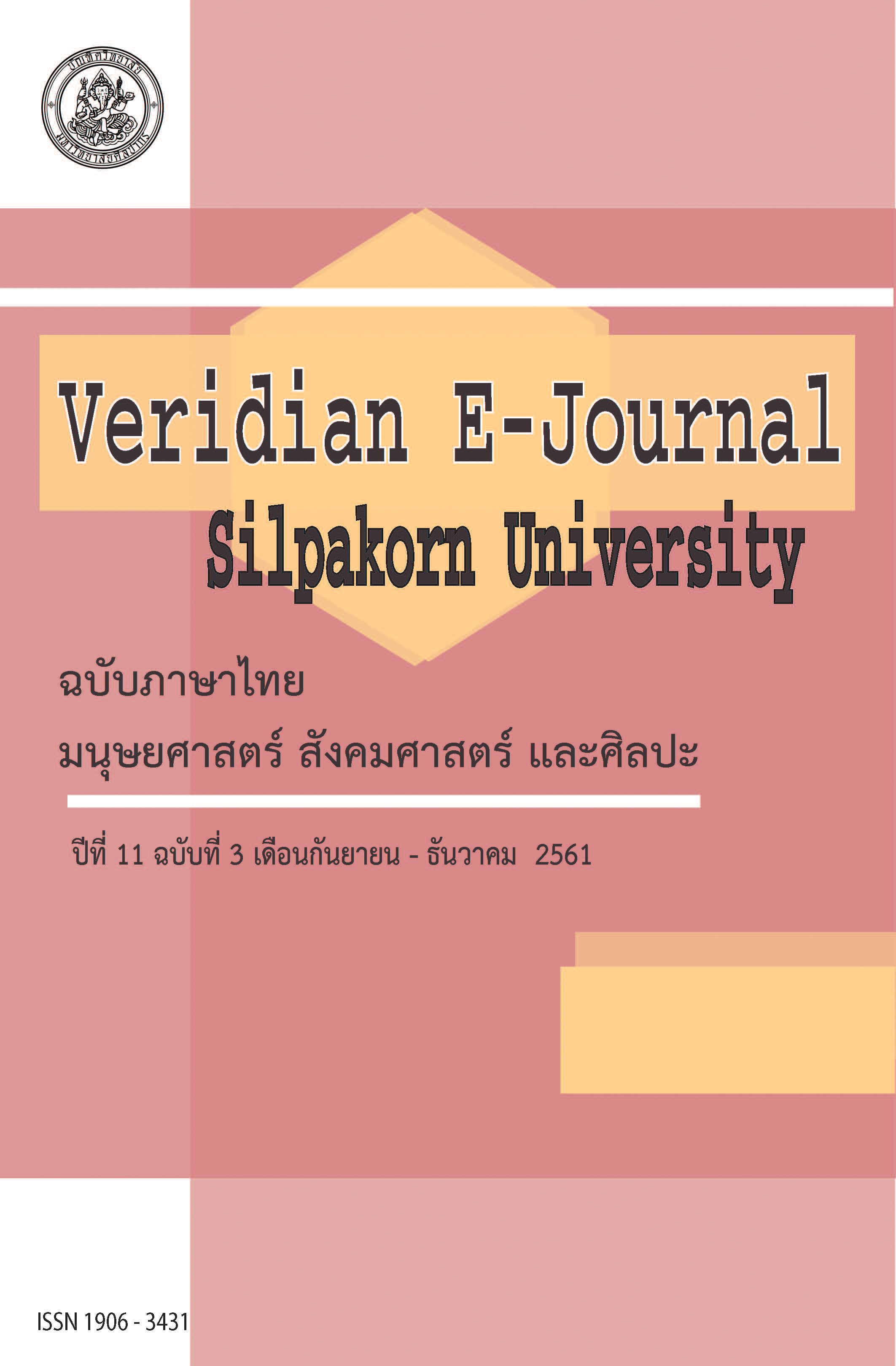ปรากฏการณ์ทินดอลล์กับความเชื่อสู่งานเครื่องประดับ (Relationship between Tyndall’s effect and belief in jewelry design)
Main Article Content
Abstract
ปรากฏการณ์ทินดอลล์หมายถึง การกระเจิงของแสง หรือลำแสง มักถูกนำมาใช้ให้เกิดสุนทรียะและความงามจากการกระทำของแสง, คอลลอยด์ และความมืด โดยมักปรากฏในภาพถ่ายและงานทัศนศิลป์ เพื่อบอกเล่าเรื่องราวเกี่ยวกับความเชื่อ ความศรัทธาความศักดิสิทธิ์ การระลึกถึง โดยการนำปรากฏการณ์มาใช้แทนค่าความเชื่อต่างๆ ผู้วิจัยจึงได้นำความงามอันเกิดจากปรากฏการณ์กระเจิงแสงประยุกต์ในการออกแบบเครื่องประดับที่สามารถแทนค่าความเชื่อและสื่อความหมาย
ผู้วิจัยใช้การศึกษาและวิเคราะห์ข้อมูลทุติยภูมิ งานทัศนศิลป์ และจากประสบการณ์ตรงของผู้วิจัย อ้างอิงแนวคิดจากทฤษฎี สัญศาสตร์ (semiotic) ซึ่งกล่าวถึงถึงความสัมพันธ์อันหลากหลาย ไม่ว่าจะเป็นตัวเรา กับ สิ่งที่ใช้แทนความหมาย เป็นแนวทางในการออกแบบ ประกอบกับการทดลอง 3 ปัจจัยที่ทำให้เกิดปรากฏการณ์ทินดอลล์ ได้แก่แหล่งกำเนิดแสง, สารประกอบที่เป็นคอลลอยด์ และภาวะแวดล้อมที่เหมาะสม เพื่อให้สอดคล้องกับการนำมาใช้งาน ตลอดจนวิเคราะห์ลักษณะร่วมของเครื่องประดับเพื่อใช้ในการค้นหารูปแบบและวิธีการสร้างสรรค์ผลงานเครื่องประดับ
ผลการวิจัยพบว่า การควบคุมแสง เมื่อผ่านควัน ในภาวะแวดล้อมที่เหมาะสมจะเกิดปรากฏการณ์ทินดอลล์ที่สามารถแสดงถึงขอบเขต ปริมาตร และขนาดที่เพิ่มขึ้น เป็นแนวทางในการออกแบบ โดยคัดเลือกวัสดุและรูปทรงของผลงานรูปทรงสมมาตร รูปทรงกลม และวงกลม ออกแบบชิ้นงานแต่ละชิ้นสามารถสวมใส่ได้หลายตำแหน่งเพื่อให้ผู้สวมใส่ตัดสินใจว่าใช้ประดับส่วนใดของร่างกายแทนค่าสัญญะความเชื่อของความเป็นเครื่องประดับ ประการต่อมา เมื่อผู้สวมใส่ได้พิจารณาทั้งก่อนและขณะสวมใส่ ขณะที่มีปรากฏการณ์ทินดอลล์และไม่มีปรากฏการณ์ แม้กระทั่งแสงและเงาที่ยังหลงเหลือบนร่างกายมีส่วนให้ทำเกิดการตีความ กล่าวคือเมื่อชิ้นงานแสดงปรากฏการณ์สื่อความหมาย อารมณ์ ความรู้สึกของผู้สวมใส่อย่างหนึ่ง เมื่อไม่มีปรากฏการณ์แสดงอีกอย่างหนึ่ง ดังนั้นการใช้ปรากฏการณ์ในเครื่องประดับสามารถสื่อถึงสัญญะทำให้ผลงานเกิดเรื่องราว และการมีอยู่หรือหายไปของปรากฏการณ์นั้นนำไปสู่การตั้งคำถาม การตีความตามประสบการณ์ของแต่ละคน เช่นเดียวกับการใช้ปรากฏการณ์ในศิลปะแขนงอื่น
Tyndall effect is the scattering of light when a light beam passes through a colloid. Its beauty and attractiveness caused by the interaction of light, colloid, and darkness has usually been used in photography and visual artworks to tell stories related to beliefs, faiths, reverence, holiness and remembrance, to which ones hold on and attach. The researcher has therefore adopted this aesthetically beautiful light effect in jewelry design, which can be used to represent and communicate scared beliefs and meanings.
In this thesis, the researcher examined and analyzed the secondary data and visual artworks, as well as applied direct experience of Tyndall effect on daily life. The concept used to frame and guide this research are drawn from the Semiotic theory which explain various kind of relationships including that between people’s selves and symbolic meaning. According to this theory, the researcher also conducted experiments, on which three factors could supposedly cause Tyndall effects. These factors included the origin and sources of light, the colloid component and the appropriate environment and setting. The aim of this was to make the designed piece of jewelry closely relevant to its usage purpose, as well as to analyze common features and functions of the designed jewelry, in order to develop models, patterns and methods of creating pieces of jewelries.
It is found from the research that a proper control of light passing through smoke screen under a proper condition can create Tyndall, by which its scope, volume and size are defined. This finding can be applied as a guideline for jewelry design. By selection the right materials and choosing the right shape be they symmetric, round or circular, the jewelry can be designed to match different parts of the wearer’s bodies depending on their connected faiths and beliefs they want to communicate. Moreover, the wearer can make decisions, both before and after wearing the designed jewelry by considering different effects they prefer. This ranger from “with or without Tyndall effects” to “leaving light or shadow on the bod parts. Either choice can create, communicate and interpret different meanings by the wearers. As a result, wearing a Tyndall effect jewelry can communicate and create feelings that are different from wearing the non Tyndall effect one. It can therefore be concluded that using effect in jewelry design can create stories and communicate meaning that the wearers associate with. The existence or disappearance of effect created by designed jewelries can also lead to the questioning and interpreting different meanings depending on the wearers’ experiences. Similarly, such phenomena of using effect in jewelry design can be found in other fields of artworks including photography and visual arts.

